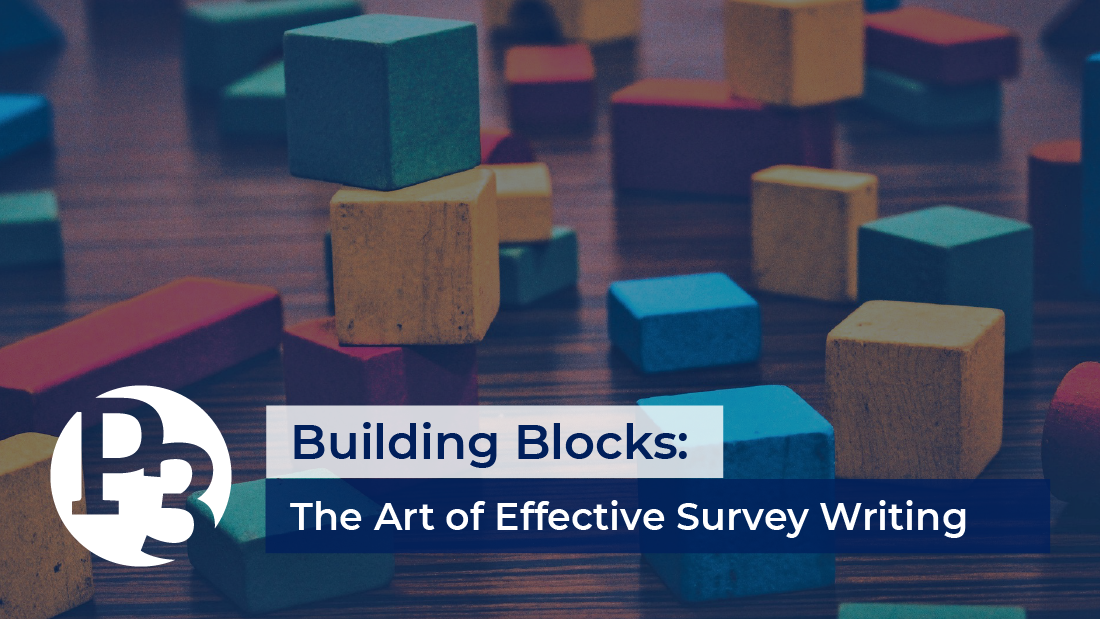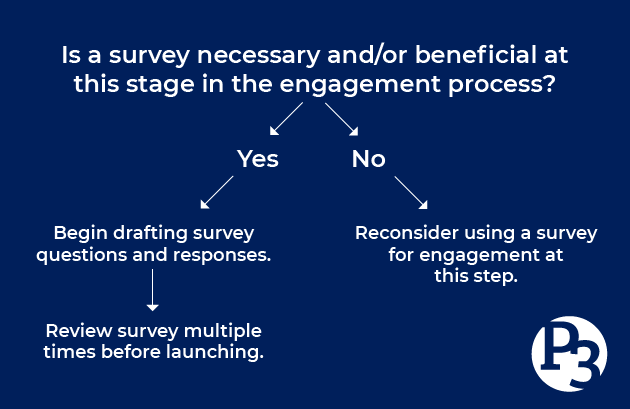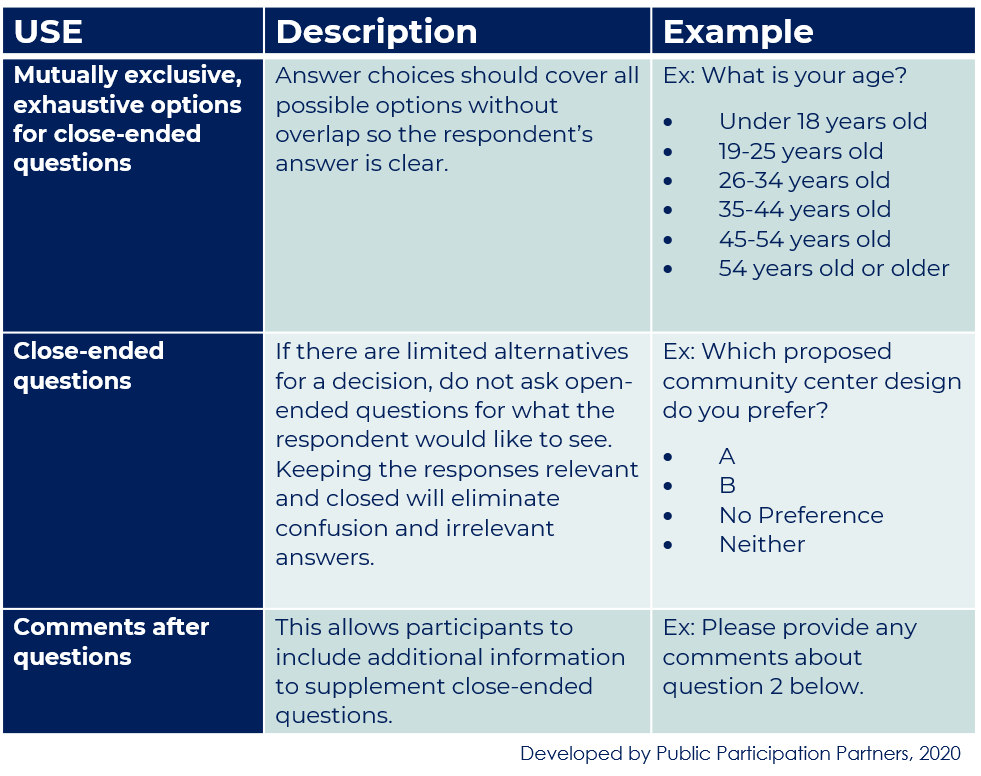
31 Jul Building Blocks: The Art of Effective Survey Writing
Surveys are an excellent way to engage a community and receive valuable data that can influence future project decisions. However, to gain the high-quality data needed for a project’s process, the survey must be designed ethically and efficiently. In our last post, we discussed the importance of ethical survey writing to receive the best data for the decision-making process. However, there are two sides to the survey writing coin. Not only is it important to make sure your surveys are ethically written, but also that they are effectively designed.
Effectively designed surveys will make the engagement experience easier and more meaningful, both for the participant and the coordinating agency. Effective surveys are more relevant and interactive and therefore more beneficial for the engagement process.
Writing an effective survey may require extensive planning and numerous drafts and revisions afterwards. However, before beginning the planning process, it’s crucial you that ask yourself if a survey is really necessary and/or beneficial.

Some decisions may not benefit from a public survey, such as decisions that are unable to be influenced by public opinion. Likewise, some stages of the engagement process may not require a survey. If you are in the initial stages of a project and the focus is on informing the public, a survey might not be your best engagement tool to use. Determine if a survey is necessary and/or beneficial before beginning survey planning to ensure that efforts are best used towards the most efficient engagement methods at the current stage of the project.
If deemed necessary or beneficial, surveys are an excellent tool to engage the public. They can bring in hundreds to thousands of perspectives from a community without requiring people to even leave their homes (which is even more advantageous with the COVID-19 pandemic!). While the amount of data is important, the quality of that data is equally if not more important. Therefore, a survey must be designed effectively to be truly successful in the engagement process.
We’ve got you covered with some tips for designing a successful survey below.
Keep it concise and relevant.
Your survey shouldn’t require an unreasonable time commitment from the participant. Surveys that are too long will have a higher rate of drop outs, or people who quit a survey before reaching the end. Keeping wording and the number of questions concise ensures that more people will complete the survey in its entirety. We recommend that your survey take no longer than five minutes to complete.
Making content relevant is an easy way to ensure a survey doesn’t take too much time. Survey questions that do not directly relate to the decision at hand will make the survey longer than necessary. Ensure that all questions are directly relevant and you are off to a good start.
Ask questions that will have useful answers.
While survey questions shouldn’t be tailored toward a specific response, they should be tailored to the information you need. In other words, if you need to know about community concerns about Avenue A, you shouldn’t ask the question “How do you like the roads in your neighborhood?” This open-ended question could lead to so many different responses that won’t help you make any decisions about Avenue A.
Instead, when developing a survey, you should keep in mind the type of information needed to make a decision. For any question that has a limited number of answers, use a close-ended question. If you would like a more in-depth answer, follow it up with a comments section for people to provide more information. This will make it easier to analyze the data while also receiving useful feedback.
Include interactive elements.
Sometimes, it may be best to include interactive elements in the survey to make participation feel more rewarding and engaging for the respondent. Interactive elements can also help participants visualize or describe a problem or idea.
There are various forms of interactive questions or activities one can include:
- A map exercise to pinpoint areas of interest for the project
- A budget exercise to emphasize where funding should be prioritized
- Questions that require respondents to group or rank options based on their priorities
While these questions may not work for all surveys, including these can create a sense of higher involvement in survey participation.
Ask demographic questions.
Demographic questions help with analysis of the survey’s engagement. By tracking demographics of survey respondents, a project team is able to see if their survey is reaching a representative sample of the study area. It then allows them to adjust outreach if some groups are not being reached effectively.
Common demographic questions may ask about:
- Zip code
- Gender identity
- Racial identity (with the option to self-identify in comments)
- Age
- English proficiency
- Household income
- Disability
Be sure to include a statement as to why you’re asking these questions. Respondents sometimes comment asking why these questions matter – now is your chance to explain! Also ensure that all demographic questions are voluntary, even if the general survey questions are not.
Review the survey before publishing. Then review again.
Always go back and double-check your survey. Read it over for grammar, spelling, and clarity of questions. Take this time to check the wording of questions to ensure neutrality. Also ensure that your language is simple and questions are free from excessive jargon. Test your survey on web and mobile browsers and make sure all questions are in order and working properly. Ask others to review and take the survey to see if you missed anything.
Now is the time to ask yourself one final time if your survey is meeting your engagement objectives. Does this survey ask relevant questions that will guide the next steps in your project? If not, revise!
Tell everyone about your survey!
It doesn’t do much good to publish a survey without advertising its existence. Now is the time to bring out other engagement formats: use mailers, postcards, social media, and other communication strategies to get the word out about your survey. The more advertising, the more people will take the survey.
It’s best to include multiple promotion posts throughout the life of the survey, but advertising is especially crucial towards the close. A few days before your survey is scheduled to close, send out reminder emails, social media posts, and more to ensure that everyone who wants to take the survey has the chance to do so.
Designing an effective survey can feel challenging at first, but over time increased practice and collaboration will lead to a set of standards that will assist your agency with designing high-quality surveys every time. Remember that the engagement process is not one-size-fits-all; each project and each decision may require different levels of engagement and outreach.
Ensure that a survey is needed in a particular stage, and keep engagement objectives in mind throughout the process. When writing a survey, taking the time to keep it relevant and engaging will produce more high-quality data and encourage more respondents to participate as well.
Miss our last post about survey ethics? Check it out here! And don’t forget to subscribe or follow us on Facebook or LinkedIn to stay updated about future blog posts.
TL;DR
About the Author: Katie Maynard started her journey with Public Participation Partners as a Community Engagement Assistant in January 2020. When not assisting with public involvement, Katie enjoys reading, travelling to the beach, and spending time with her pets.



Sorry, the comment form is closed at this time.